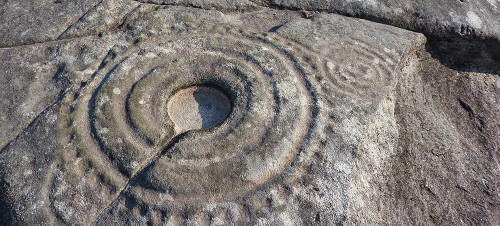|

by Jesus Diaz
May 21, 2014
from
Gizmodo Website

"We can say little, if anything,
about what these patterns [above] signify, why they were cut
into rocks, or who created them. For all intents and purposes,
they might have been made by aliens."
When a new NASA book on alien
communications has a paragraph like that, you better pay
attention.
Of course, the scientists and scholars
who contributed to
'Archaeology,
Anthropology and Interstellar Communications'
- edited by Douglas A. Vakoch - are not saying these
carvings were made by aliens.
They're saying that, since we don't
really know the origin and meaning of these markings - which were
made thousands of years ago all cross Europe, America and India - we
can assume that they are made by aliens as a test to what
we may encounter when we actually make contact with a civilization
from another planet.
It's a serious book - deep and complex,
but quite accessible. I have been going through it and it is truly
fascinating stuff.
And I'm not only talking about the gem
at the top of this article:
Consider again, therefore, the
desirability of establishing symbolic/linguistic communication
with ETI [Extra-Terrestrial Intelligence].
It is helpful to review some
parallels from human existence that pose problems for us today.
One of these is "rock art," which consists of patterns or shapes
cut into rock many thousands of years ago. Such ancient stone
carvings can be found in many countries [...]
We can say little, if anything,
about what these patterns [above] signify, why they were cut
into rocks, or who created them. For all intents and purposes,
they might have been made by aliens.

A replica of an unusual cup-and-ring-marked stone
from Dalgarven, North Ayrshire,
Scotland.
The larger picture
That's only a tiny part of
a much larger logical chain that takes into consideration our
knowledge on historical and prehistorical Earth, as well as our
understanding of biology, evolution, and physics.
For example, after going through a
number of assumptions about the potential physical and
biophysical differences in Chapter 15 - titled Constraints
on Message Construction for Communication with Extraterrestrial
Intelligence - Vakoch writes about the implications:
Implications - I
If the reader accepts these
assumptions, then our first constraint on possible messages
is simple: don't think of
"sound worlds" or music or speech as the domains, vehicles,
or contents of ETI messages.
Regardless of semiotic concerns
(see below), the
accessibility of acoustic messaging must remain doubtful.
Furthermore, there will be intended and unintended aspects
of performance, which elaborate the difficulties of using
sound. In my view avoidance of the sound world need not be
controversial.
On the other hand,
vision and the use of
images would appear to be at least plausible.
Although spectral details cannot
be considered universal,
the physical arrangement of objects on a habitable planet's
surface will be shaped in part by gravity (the notion of a
horizon might well be universal) and thus multispectral
images might plausibly be considered worthwhile for
messages.
More generally, the implications
for considering SETI/CETI as some sort of anthropological
challenge need teasing out.
Makes total sense to me.
I won't quote more of the book here
because that would be a worthless exercise, but so far - I'm
still eagerly reading it - it's a really great read.
It's comforting that NASA is
thinking about human-alien communication under a new focus, one
that is not purely based on the physical sciences of planetary
research or exobiology, but that ties it with our current
experience in trying to decipher our own archeological and
anthropological past.
That, according to Vakoch, is the
objective of this volume:
The chapters in this volume
combine incisive critique with hope that there is a response
to the skepticism behind these critiques.
Addressing a field that has been
dominated by astronomers, physicists, engineers, and
computer scientists, the contributors to this collection
raise questions that may have been overlooked by physical
scientists about the ease of establishing meaningful
communication with an extraterrestrial intelligence.
These
scholars are grappling with
some of the enormous challenges that will face humanity if
an information-rich signal emanating from another world is
detected.
By drawing on issues at
the core of contemporary
archaeology and anthropology, we can be much better
prepared for contact with an extraterrestrial civilization,
should that day ever come.
|


